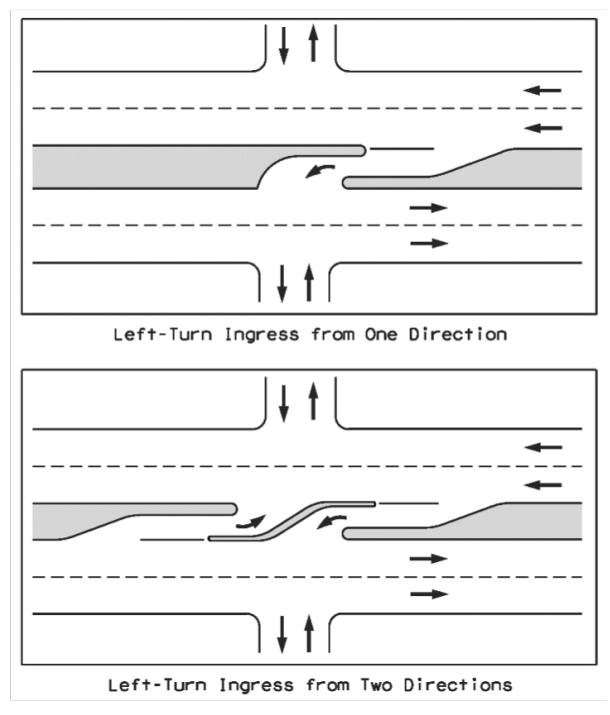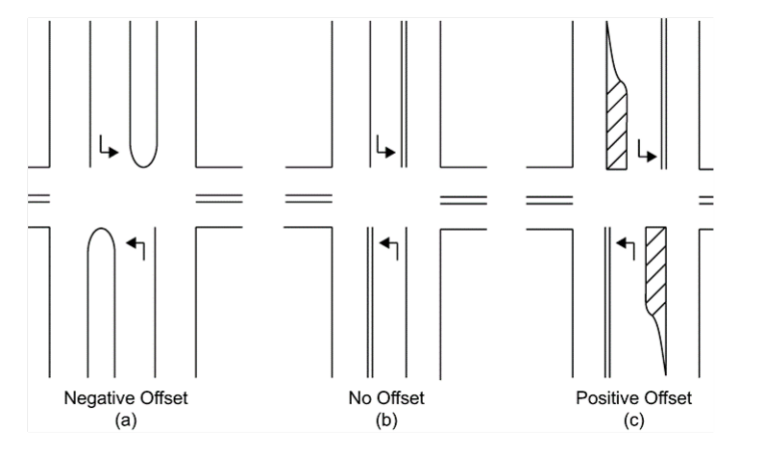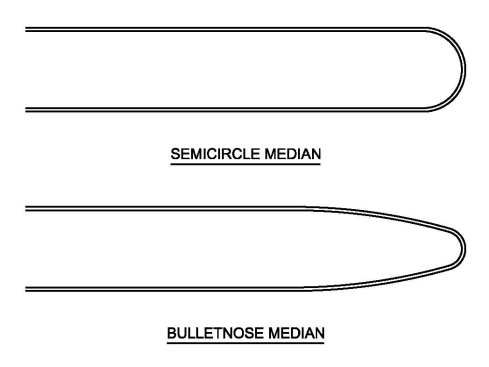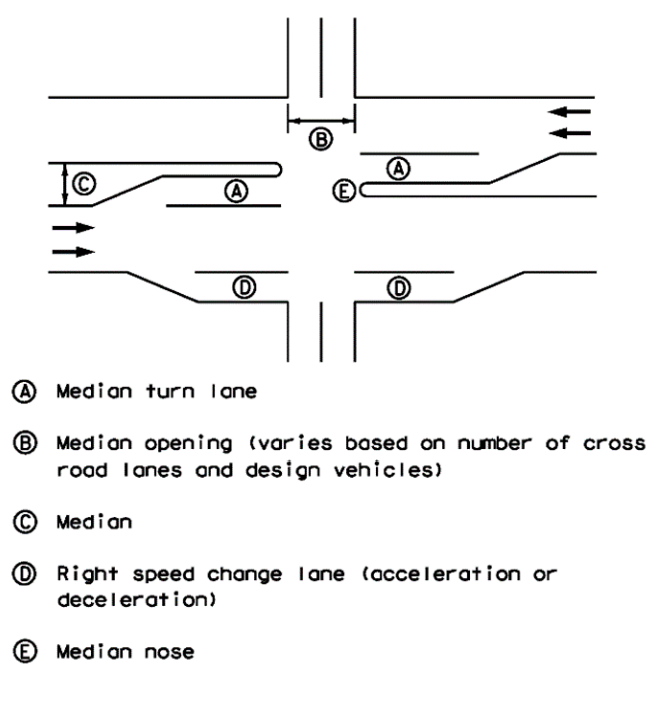4.10.15 Medians
A median (i.e., the area between opposing travel lane edges) is provided primarily on divided highways to separate opposing traffic streams. The general range of median width is from 4- to 76-ft. The design width is dependent on the context classification and traffic characteristics of the highway or street facility. When determining the minimum median width, consideration should be given to the demand for U-turn movements based on local access requirements. See
for minimum median width required to accommodate various design vehicles.
The primary functions of medians are to provide the following:
- Storage space for left-turning vehicles;
- Separation of opposing traffic streams; and
- Access control to/from minor access drives and intersections.
The types of medians that are commonly used include:
- Depressed;
- Raised;
- Flush; and
- Two-Way Left Turn Lanes (TWLTL).
4.10.15.1 Depressed Medians
Depressed medians are generally found in the rural context and will range from 48- to 76-ft in width. This type of median shares a common ditch between each side of the divided facility and offers an area for storm runoff to collect. This type of median can also provide storage space for snow during snow removal operations.
For multi-lane rural highways without access control, a median width of 76-ft is preferable to provide complete shelter for trucks at median openings. These wide, depressed medians are also effective in reducing headlight glare and providing a clear zone for run-off-the-road vehicle encroachments. They also provide a pleasing appearance and reduce chances of head on collisions. Wide medians should generally be used whenever feasible but median widths greater than 60-ft have been found to be undesirable for intersections that are signalized or may be signalized in the design life of the project. The increased time for vehicles to cross the median can lead to inefficient signal operation.
Areas that are likely to become suburban or urban in nature may require future signalization at intersections. Medians wider than 60-ft should be avoided at these intersections.
Where economically feasible, freeways in rural areas should also desirably include a 76-ft depressed median. However, since freeways by design do not allow at-grade crossings, median widths do not need to be sufficient to shelter crossing trucks. In this regard, where ROW costs are prohibitive, reduced median widths (less than 76-ft) may be used. Statistical studies have shown that over 90 percent of median encroachments involve lateral distances traveled of 48-ft or less. To account for this, unless continuous longitudinal barriers are used, depressed medians on rural freeway sections should be 48-ft or more in width.
4.10.15.2 Raised Medians
A raised median is used where it is desirable to control or restrict mid-block left turns and crossing maneuvers. Installing a raised median can result in the following benefits:
- Restricting left-turn and crossing maneuvers to specific locations or certain movements;
- Improving traffic safety;
- Increasing throughput capacity and reducing delays; and
- Providing pedestrian refuge areas.
This type of median can typically be found on roadways in the suburban, urban, or urban core contexts and may range from 4 to 36-ft in width.
On high-speed facilities, mountable curb should be used for the raised median.
A raised median design should be considered where:
- ADT exceeds 20,000 VPD;
- New development is occurring, and volumes are anticipated to exceed 20,000 VPD; or
- There are operational concerns for midblock turns.
For these conditions, a raised median may improve safety by separating traffic flows and controlling left-turn and crossing maneuvers. The use of raised medians should be discouraged where the roadway cross-section is too narrow for U-turns.
For median left turn lanes at intersections, a width of 16-ft will effectively accommodate left-turning traffic and a 4-ft median divider measured from the face of curb. However, where pedestrian refuge is a consideration for raised medians, allowances for a 6-ft width raised median, measured from the back of curb, is preferred, (6-ft measured from the face of curb is the minimum requirement). See
for additional guidance.
An 18-ft median is preferred to accommodate the 6-ft pedestrian refuge in the median, rather than providing 10-ft left turn lanes.
An illustration of this difference is shown in
.
To prevent recurring damage to the raised median divider, the divider should be at least 2- ft wide (measured from face of curb to face of curb). If pedestrians are expected to cross the divider, then the divider should be a minimum of 5-ft wide (normal to direction of pedestrian travel) to accommodate a cut-through landing or refuge area that is at least 5-ft x 6-ft.

Figure 4-24: Median Left Turn Lanes with and without Pedestrian Refuge
4.10.15.3 Flush Medians
Flush medians are medians that can be traversed. A flush median cannot prevent left-turn and cross maneuvers since it can be easily crossed and cannot physically prevent these types of movement. Therefore, for roadways where access control is desirable, flush medians should not be used. When flush median designs are selected, it should be expected that some crossing and turning movements can occur in and around these medians. Full pavement structure designs will usually be carried across flush medians to allow for traffic movements.
A flush median design should include the following:
- Delineation from through lanes using double yellow stripes and possibly a contrasting surface texture or color to provide visibility; and
- Flexibility to allow additional left-turn bay storage if necessary.
This type of flush median is generally located on roadways in the rural or suburban contexts with roadside development and may range from 4- to 16-ft in width. 4-ft wide flush medians provide little separation of opposing traffic and minimal refuge area for pedestrians. 14- to 16-ft wide flush medians offer space for traffic turning left but does not offer protection for crossing vehicles.
Urban and suburban freeways generally include narrower, flush medians with continuous longitudinal barriers. The median width may vary from 24- to 30-ft, with 24-ft commonly used. See
for recommendations on the use of median barriers. See
for additional information on freeway medians.
4.10.15.4 Two-Way Left-Turn Lanes
TWLTL are flush medians that may be used for left turns by traffic from either direction on the roadway. The TWLTL is appropriate where there are operational concerns for a high frequency of mid-block turns exist or are anticipated, such as areas with (or expected to experience) moderate or intense strip development. Used appropriately, the TWLTL design can improve the safety and operational characteristics of streets as demonstrated through reduced travel times and crash rates. Recommended median lane widths for the TWLTL design are as shown in
. When applying this criterion to new location projects or on reconstruction projects the corresponding preferable width should be used where widening necessitates the removal of exterior curbs. Minimum values shown in
are appropriate for restrictive ROW projects and improvement projects where attaining the desirable width would necessitate removal and replacement of exterior curbing to gain a small amount of roadway width.
Design Speed (mph) | Width of TWLTL (ft) | |
Preferable 1 | Minimum | |
≤ 40 | 14 | 11 |
45 or 50 | 14 | 12 |
>50 | 16 | 14 |
Notes: | ||
| ||
A site can be considered suitable for the use of a TWLTL when the facility meets the following criteria:
- Future ADT volume of greater than:
- 3,000 VPD for an existing two-lane facility,
- 6,000 VPD for an existing four-lane facility, or
- 10,000 VPD for an existing six-lane facility; and
- Side roads plus driveway density of 20 or more entrances per mile for both directions of travel for urban context or 10 or more entrances per mile for both directions of travel for suburban context.
All cross sections should be evaluated for pedestrian crossing capabilities. See
for additional guidance.
4.10.15.5 Median Openings
For rural town, suburban, urban, and urban core contexts, median openings should only be provided for street intersections or at intervals for major developed areas. Spacing between median openings must be adequate to allow for introduction of left-turn lanes and to prevent false calls at signal detection loops.
As the number of median openings increase, the interference between through traffic and turning traffic increases. To reduce the conflicts between turning traffic and through traffic, turn bays should be provided at all median openings. Recommended minimum median opening spacings are based on the length of turn bay required.
Directional openings, pictured in
, can be used to limit the number and type of conflicts.

Figure 4-25: Types of Directional Openings
The positive offset design shown in
can improve the sight distance for left-turning vehicles where there are opposing left-turn lanes. This design has also been found to substantially reduce the frequency of left-turn crashes compared to negative (a) or no offset (b) designs and is desirable for use where practical. Further discussion and examples of offset left-turn lanes can be found in
.

Figure 4-26: Examples of Left-Turn Lanes with Negative, Zero, and Positive Offset
Source: AASHTO’s A Policy on Geometric Design of Highways and Streets
An important factor in designing median openings is the shape of the median end or median nose. The median end shape can directly alter the effective turning path the design vehicle can make.
The shape of a median nose should be designed to accommodate the turning path of the design vehicle.
One form of a median end at an opening is a semicircle, which is a simple design that is satisfactory for median widths less than 10-ft wide. One alternate median end design that fits the paths of design vehicles is a bullet nose. The bullet nose is formed by two symmetrical arcs with a small radius to round the nose.
See
for an illustration of these two types of median ends.

Figure 4-27: Types of Median Ends
Consider the use of local design standards for median noses where available. In the absence of a local standard refer to Chapter 9 of
for more information regarding the design of median openings.
On rural divided highways, closely spaced median openings can cause interference between high-speed through-traffic and turning vehicles. The frequency of median openings varies with topographic restrictions and local requirements. As a general rule,
the minimum spacing should be one-quarter mile or greater in rural areas.
It is typical to provide median openings at all public roads and at major traffic generators such as industrial sites or shopping centers. Additional openings should be provided to maintain a maximum one-half mile spacing.As shown in
, rural divided highways should provide left-turn lanes at all median openings and right-turn deceleration and acceleration lanes should be considered at intersections with highways or other major public roads with significant turning movements. See TxDOT’s
“Auxiliary Lanes” section and related table for additional considerations and warranting thresholds for right-turn deceleration and acceleration lanes as well as left-turn deceleration lanes at median openings.
For divided highways with independent mainlane alignment, particular care should be exercised at median openings to provide a satisfactory profile along the crossover with flat approaches to the mainlanes.
For divided highways with independent mainlane alignment, particular care should be exercised at median openings to provide a satisfactory profile along the crossover with flat approaches to the mainlanes.

Figure 4-28: Multi-Lane Rural Highway Intersection
Median openings should be at least 40-ft wide, or the width of the crossroad pavement plus 8-ft.
Design vehicles are often used as the basis for minimum design of median openings, particularly for multilane crossroads and skewed intersections.
See
for additional information.4.10.15.6 Median Encroachment Design Guidance and Countermeasures
Median encroachment countermeasures should be considered where appropriate. High severity injuries and fatalities are a result of cross median crashes on high-speed roadways. Reducing median encroachment reduces cross median crashes and fixed object crashes in the median. The following guidelines below are for reducing the frequency and severity of median related crashes on divided highways:
Design Guidance to Reduce Consequences of Median Encroachments:
- Minimize potential for collision with fixed objects:
- Relocate or remove fixed objects in median.
- Reduce consequences of collision with fixed objects:
- Provide barrier to shield objects in median.
- Reduce likelihood of cross-median collisions:
- Provide wider median; and
- Provide continuous median barrier.
- Reduce likelihood of vehicle overturning:
- Flatten median slopes;
- Provide U-shaped (rather than V-shaped) median cross section; and
- Provide barrier to shield steep slopes.
- Improve design of geometric elements:
- Provide wider median;
- Minimize sharp curves with radii less than 3,000 feet; and
- Minimize steep grades of four percent or more.
- Improve design of mainline ramp terminals:
- Increase separation between onramps and off-ramps.
- Minimize left-side exits:
- Improve design of merge and diverge areas by lengthening speed-change lanes;
- Simplify design of weaving areas; and
- Increase decision sight-distance to on-ramps.
Countermeasures to Reduce Likelihood of Median Encroachments:
- Reduce driver inattention:
- Provide edge-line or shoulder rumble strips.
- Decrease side friction demand:
- Improve/restore superelevation at horizontal curves.
- Increase pavement friction:
- Provide high-friction pavement surfaces.
- Reduce high driver workload:
- Improve visibility and provide better advance warning for onramps;
- Improve visibility and provide better advance warning for curves and grades; and
- Improve delineation.
- Encourage drivers to reduce speeds:
- Provide transverse pavement markings.
- Minimize weather-related crashes:
- Provide weather-activated speed signs;
- Provide static signs warning of weather conditions (e.g., bridge freezes before road surface);
- Apply sand or other materials to improve road surface friction;
- Apply chemical de-icing or anti-icing as a location-specific treatment;
- Improve winter maintenance response times; and
- Raise the state of preparedness for winter maintenance.